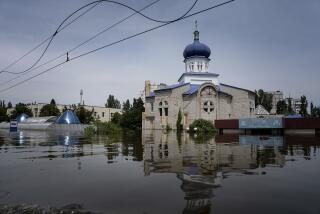Report Predicts Thirstier World
- Share via
UNITED NATIONS — “Whiskey’s for drinking, water’s for fighting about,” Mark Twain is said to have observed, and on Monday, scientists warned that more people may be fighting over water this century than over oil.
A report issued Monday at the U.N.-sponsored World Water Forum in Stockholm says that one in three people will not have access to enough water by 2025 and that it is unlikely that traditional agriculture could feed the world’s population by then. Already, bottled drinking water costs more per gallon than gas around the world, and it is bound to become even more precious.
Water shortages affect about 450 million people in 29 countries, and tensions over water rights in Asia and Africa could erupt into serious clashes if governments don’t find new ways to use existing supplies more efficiently, the report warns.
“Water could become the new oil as a major source of conflict,” Dutch Crown Prince Willem-Alexander, chairman of the 2000 World Water Forum, said after opening the Stockholm conference Monday.
“Increasing scarcity, competition and arguments over water in the first quarter of the 21st century will dramatically change the way we value and use water and the way we mobilize and manage water resources,” he said.
From clashes over the use of local watering holes to disagreements between countries over the right to dam a shared river to corporations’ desire to privatize distribution, water has already become a major source of strife. While few wars have been fought over water outright, political disagreements are intensified when such essential resources become scarce.
Californians are familiar with the challenges of making a city grow from a desert. Just as Los Angeles had to siphon water from rivers and watersheds hundreds of miles away as its population exploded, rapidly expanding cities in Asia and sub-Saharan Africa are thirsting for adequate supplies for drinking and sanitation.
Despite innovations that have lowered costs of water treatment, more than a billion people still lack safe drinking water, said Sandra Postel, director of the Global Water Policy Project based in Amherst, Mass. “We’re running as fast as we can just to stay in one place,” she said.
Rural, agricultural areas are threatened the most, the report says. A combination of global warming, wasteful practices and pollution means that major rivers that traditionally have been relied on by millions of people are now running dry for part of the year. The Yellow River in China, the Nile in Africa and the Indus and the Ganges in south Asia don’t always reach the sea during the dry season, leaving farmers struggling. Agricultural scientists are trying to find ways to grow more food with less water to prevent famine in the next 25 years.
“There’s not enough water available to produce enough food. That’s the problem,” said Peter Gleick, director of the Pacific Institute for Studies in Development, Environment and Security in Oakland.
There is no shortage of answers when scientists, government leaders and environmentalists gather at a meeting like the one in Stockholm--just a lack of consensus.
There are many small things that can be done that could have broad effects on water use around the world, Gleick said. Farmers can choose more water-efficient crops to produce “more crops per drop.” Consumers can rethink their diets: It takes 16 times as much water to produce a ton of beef as a ton of grain, Gleick said.
“There are people who say we’re heading for disaster and those who say we don’t have a problem,” he said. “It all depends on the choices we make.”
More to Read
Sign up for Essential California
The most important California stories and recommendations in your inbox every morning.
You may occasionally receive promotional content from the Los Angeles Times.













